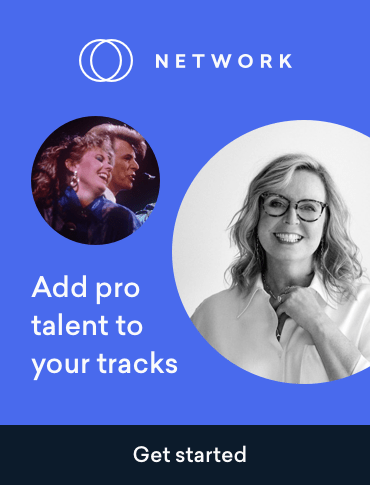
What does a Backing Vocalist Do?

Vocals are the focal point of a song. They’re the human element that gives a song its emotional weight.
Lead singers get plenty of recognition for the star power they can bring to a track.
But there’s another tradition in studio singing that’s just as essential—backing vocals.
One person who knows the backing vocalist’s role inside out is British educator, broadcaster and backing singer Tessa Niles.
Tessa has sung with a laundry list of legendary artists from Duran Duran and the Pet Shop Boys to the Rolling Stones.
Her career highlights include a 12 year stint recording with Eric Clapton and performing with David Bowie during his iconic appearance at Live Aid.
We sat down with Tessa to talk technique, collaboration and the craft of a session vocalist for the launch of LANDR Network
What does a backing vocalist do?
Backing vocals have been an important sound in pop, rock and R&B for decades.
But in the public’s imagination, backup singers are often dismissed as a superficial element of glamorous stage productions.
In reality, studio vocals, whether as a backing vocalist or topliner, are a craft just like any other discipline in recording—one that requires its own brand of skill and finesse.
As Niles explains, the silver screen version of the backup singer is the first thing people get wrong about the role.
“The public’s perception of what a backing vocalist does versus what we seem to do versus what they actually do is very, very different. I think because there is a visual element to it people don’t really think about how things work in the studio and why backing vocals are so integral to record making.”

The language of pop
It’s easy to take it for granted that music has always had backing vocals.
But the classic sound we associate with the pop traditional didn’t come out of nowhere.
It’s a longstanding musical practice with roots in one of the oldest vocal clichés—call and response.
“So many powerful records throughout history have used a call and response figure—especially within a chorus. The backing vocals are used in that situation to reinforce the chorus and the hook—they can even become the central hook themselves.”

That reinforcement has the power to completely transform a song.
The interplay between foreground and background is where backing vocals create a sense of polish and sophistication.
“Think of a song like ‘Respect.’ You can’t disentangle the lead vocal from the backing vocals. They’re a part of each other. It’s completely integral to the overall sound.”
“When I worked with [Rolling Stones producer] Chris Kinsey, he used to say that when the female vocalists came in, it was like sprinkling fairy dust over the track. It’s that different colour or texture that really makes the right bits stand out.”
Vocal shape-shifting
If there’s one essential quality in a backing vocalist, it’s the ability to adapt to any musical situation.
Providing essential support for the lead vocal while leaving room for everything else in the mix requires an especially versatile voice.
For Tessa, it’s one of the reasons lead and backing vocals are completely different.
But no matter how flexible the singer, the right attitude is even more important.
“Lead singers often make terrible backing vocalists because they have a very distinct sound by nature. It’s what sets them apart. But as a backing vocalist, you have to be a vocal shape-shifter—a vocal chameleon, like an actress using one singing voice.”
“Complimenting the lead vocalist is the most important thing. You have to remove your ego because you don’t want to pull that focus away. It’s about being a team player, working to your strengths and supporting the lead singer to make them sound as good as they possibly can.”
That sense of awareness is vital in situations where things aren’t going so smoothly.
As Tessa explains, even the most chameleonic singer might not be the right fit for every single session.
The key is to be aware when it’s not working, and keep it professional.
“I’m not under the misunderstanding that I’m right for every gig. Just because you’re a session musician and you can move and change and shift direction at the drop of a hat doesn’t necessarily mean that you know you’re gonna be right for every gig. It’s about finding what you do best, and that’s a great journey to be on.”

Creativity and results
Despite the emphasis on support, backing vocalists are also called on for their creative input.
According to Niles, it comes down to do the individual producer’s style and workflow.
“It’s very much dependent on the producer, whatever the producer wants. I’ve worked for many producers who have a very clear vision of what they want the track to sound like. They’ll instruct you as to what they want and it’s kept to that.”
As restrictive as it may sound, Niles is quick to note that the workflow has its benefits.
“I’m more than happy to work with a brief. It’s actually a wonderful way to work. It’s a very clear and quick way of working that’s great for getting a lot done in less studio time.”
But when the opportunity arises, she’s keen to contribute creatively.
“Some producers I’ve worked with—like Trevor Horn for example—want to get you creating right from the get-go. They’ll have a basic idea of where they’d like the vocals to be, but still allow you a great amount of kind of creative input. It’s so fulfilling on both sides to work that way.”
Generating ideas on the spot can lead to unexpected results:
“It can be like going down a rabbit hole. You’re trying 60 million different versions. Some of it sticks and some of it will never see the light of day but it’s all fun and creative!”
Collaboration
No matter who’s involved, collaboration is the heart of a session vocalist’s work.
Supporting the artist and session effectively is priority number one.
For Tessa, being an effective collaborator means maintaining a high standard, even in longstanding creative relationships:
“Just because you have a relationship with a band or a producer doesn’t mean you can get complacent. I think it’s something that needs constant work and attention. You should ever feel that you have a job for life with anyone!”
Networking
Vocalists with this special skill set were in high demand at the peak of the studio era.
Back then it was common for producers to assemble a team of regular contributors to call depending on the session and talent required.
For Tessa, making it to the call lists of high profile artists and producers was a sign of lasting success.
This type of big budget production is less common in the streaming era.
But the idea of a tight-knit community of collaborators that depend on each other’s skills has persisted.
In the label-driven heyday of the studio system, making those connections often meant working with gatekeepers like agents and managers.
Access to top talent wasn’t easy to get unless you had the right connections. That’s all changed with platforms like LANDR Network.
It’s clear that working with talented collaborators is the key to doing your best work.
With Network you can find exactly the right person to contribute to your project—and make them part of your community along the way.
“Things are very different now. There are thousands more singers, all trying to vie for the same work. LANDR Network is the most extraordinary opportunity for people because with a marketplace you can forgo agents and managers—they can be extraordinarily helpful, but you pay a price for that.”
Gear guides, tips, tutorials, inspiration and more—delivered weekly.
Keep up with the LANDR Blog.



